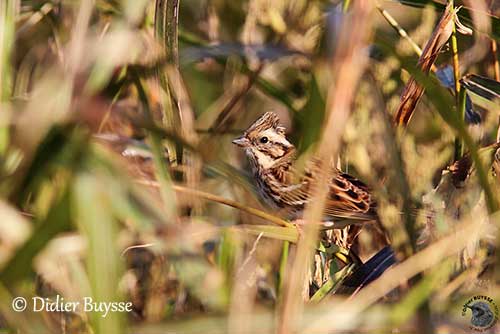
Fr: Bruant rustique
Ang: Rustic Bunting
All: Waldammer
Esp: Escribano Rústico
Ita: Zigolo boschereccio
Nd: Bosgors
Sd: Videsparv
Photographers:
Aurélien Audevard
OUESSANT DIGISCOPING
Didier Buysse
Vision d’Oiseaux
Tom Grey
Tom Grey's Bird Pictures & Tom Grey's Bird Pictures 2
William Price
PBase-tereksandpiper & Flickr William Price
Text by Nicole Bouglouan
Sources :
HANDBOOK OF THE BIRDS OF THE WORLD Vol 16 by Josep del Hoyo- Andrew Elliot-David Christie – Lynx Edicions – ISBN: 9788496553781
THE HANDBOOK OF BIRD IDENTIFICATION FOR EUROPE AND THE WESTERN PALEARCTIC by Mark Beaman, Steve Madge - C. Helm - ISBN: 0713639601
BIRDS OF THE MIDDLE EAST by R.F. Porter, S. Christensen, P Schiermacker-Ansen C.Helm - ISBN: 0713670169
GUIDE HEINZEL des Oiseaux d’Europe de Hermann Heinzel, Richard Fitter et John Parslow – Delachaux et Niestlé – ISBN : 2603014862
ENCYCLOPEDIE DES OISEAUX DE FRANCE ET D’EUROPE – de Peter Hayman et Rob Hume - Flammarion – ISBN : 2082009920
What Bird-The ultimate Bird Guide (Mitchell Waite)
Wikipedia, the free encyclopaedia
New records for Project FeederWatch - Rustic Buntings in North America
Population decline in the Rustic Bunting in Norway by Svein Dale & Kjetil Hansen
Rustic Bunting
Emberiza rustica
Passeriformes Order – Emberizidae Family
INTRODUCTION :
The Rustic Bunting is relatively small but with stocky body. It often exhibits a typical “half-crested” appearance when the crown feathers are raised.
This species is often considered the Old World equivalent of the North American sparrows.
The Rustic Bunting breeds in northern Europe and Asia in swampy lowland coniferous forests. During winter, it migrates to C and E Asia, and can be found in drier forested habitats. However, this species regularly occurs in W Aleutians, and is considered a vagrant in North America.
The Rustic Bunting is not globally threatened.

DESCRIPTION OF THE BIRD:
Biometrics:
Length: 13-14,5 cm
Weight: 15-24 g
The Rustic Bunting adult male in breeding plumage has usually reddish-brown with blackish streaks mantle and upperparts, and reddish nape and neck sides. The tail is dark brown with white inner webs on the two outermost pairs of rectrices. On the upperwing, two white wingbars are formed by the pale tips of the dark brown median and greater coverts. The dark brown flight-feathers show pale to rufous-brown edges.
The underparts are white, including chin and throat, but we can see a conspicuous reddish V-shaped breastband. The flanks are variably streaked reddish.
On the head, the crown is black with white spot on rear centre. There is a conspicuous white supercilium, extending from above the eye to the nape. Lores and ear-coverts are black with white spot on rear of ear-coverts. We can see a broad, white submoustachial stripe extending to below the ear-coverts, and a weak, indistinct, black malar stripe. The crown feathers are sometimes slightly raised, forming a short-pointed crest.
The pointed bill is dark grey with pinkish base of lower mandible. The eyes are dark chestnut-brown. Legs and feet are pinkish to flesh.
The non-breeding male has same pattern in fresh plumage, but on the head, the black areas are tinged brown, whereas the white areas, including chin and throat, are tinged buffish. Lores and ear-coverts are buffy-brown.
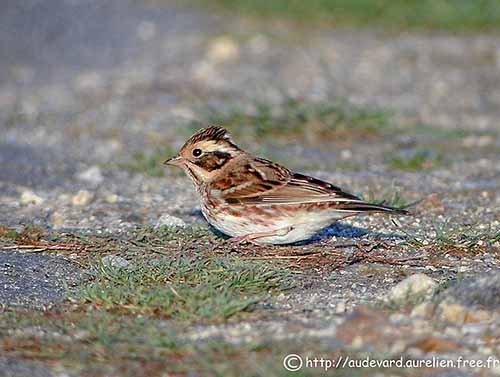
The Rustic Bunting adult female in breeding plumage resembles breeding male but she is duller overall. On the head, the dark areas are mostly chestnut-brown, and breastband and flanks are tinged dark brown. She has more mottled rump, and the pale wingbars are mostly creamy-white.
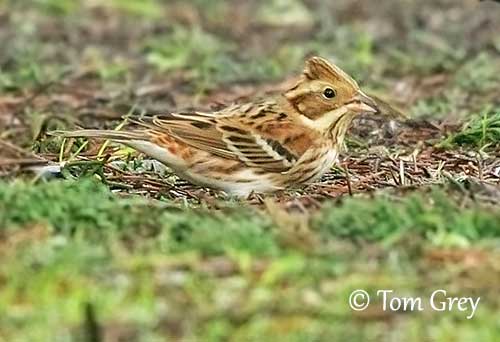
First winter male and female resemble non-breeding adults, but they differ in iris colour that is duller, and pointed rectrices.
The juvenile resembles first winter female but it has more streaked breast and dark grey-brown eyes.
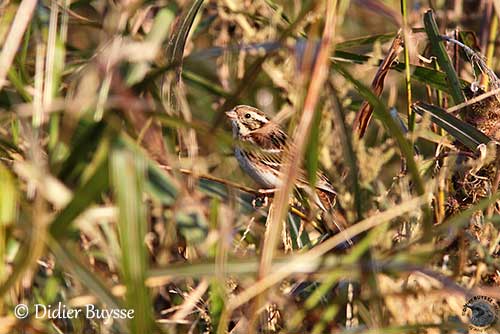
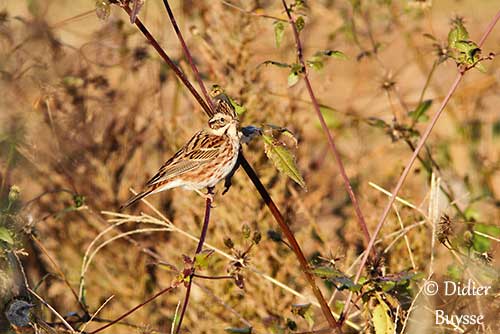
RANGE:
The Rustic Bunting is mainly an Eurasian species, and the usual breeding range extends from Scandinavia to northern Siberia. It winters in China or Japan.
This species occasionally wanders to North America, and is almost a regular migrant on the W Aleutians, usually in spring, and occasionally in W Alaska. During autumn and winter, some birds can be seen along the Pacific Coast, S to California. It is a rare wanderer to W Europe.
HABITAT:
The Rustic Bunting breeds in swampy lowland coniferous forests with Picea, Pinus, Betula and Salix trees, but also in deciduous woodlands, streamside with scrub and bushes around Sphagnum bogs.
It favours areas with stunted pines and dead trees covered with moss. Throughout its breeding range, it is usually found in wet, swampy areas.
Outside the breeding season, it occurs in drier habitats including lowland forest and more open areas such as field edges with nearby bushes and thickets.
CALLS AND SONGS: SOUNDS BY XENO-CANTO
The Rustic Bunting gives short, sharp “zit” or a softer “tsik” often repeated at short intervals. The alarm call is a penetrating, thin “tseee” generally uttered on the breeding grounds.
The song is a clear, thin, rather mournful but melodious warbling “Dudeleu Dii-dah deluu-delee”. This song is often given from treetop.
BEHAVIOUR IN THE WILD:
The Rustic Bunting feeds mainly on insects and seeds found in wet areas during the breeding season. Invertebrates include Odonata, Plecoptera, Trichoptera, Diptera and others such as Coleoptera, caterpillars, adult Lepidoptera, Hymenoptera, grasshoppers and spiders.
The plant items include seeds of Poaceae (Gramineae), several cereals and sedges, and seeds of conifers.
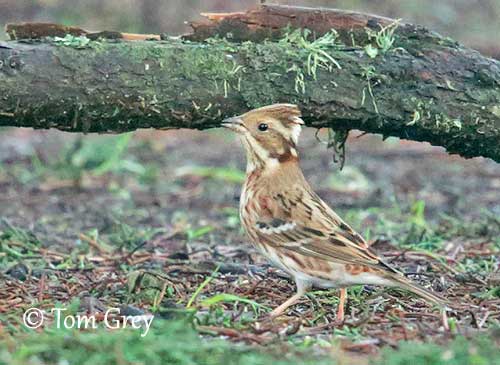
The Rustic Bunting forages on the ground, but it also gleans insects from the low vegetation.
During winter, they can be found in small groups, like during the migrations. However, larger flocks of up to 400 birds are common on the wintering areas.
The Rustic Bunting is monogamous like most Emberizidae. During the egg-laying period, the male performs mate-guarding and stays close to the female. It is territorial during the breeding season. They nest on the ground among the vegetation.
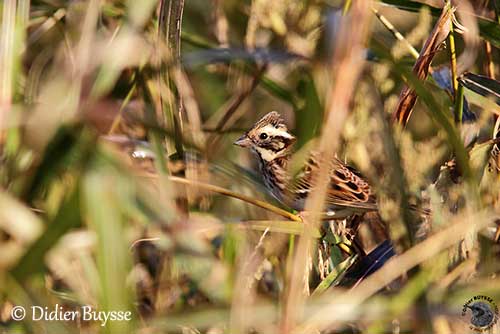
The Rustic Bunting is migratory. Males usually arrive at the breeding grounds before the females.
It has direct but slightly undulating flight.
REPRODUCTION OF THIS SPECIES:
The breeding season starts in May/June, later in the eastern parts of the range with nest-building in June.
The nest is built by the female, but the male collects some materials and may help the female. The cup-shaped structure is made with grass, stems, moss, leaves and conifer needles. The cup is lined with softer materials including finer grass, hair and feathers. It is built on the ground, hidden among vegetation or roots, or under bush or overhanging plant, occasionally up to 4-5 metres above the ground in tree or stump.
The female lays 4-5 pale blue or green eggs with darker markings. The incubation lasts 11-13 days, shared by both adults, but mainly by female. The chicks are fed by their parents and leave the nest before to be able to fly, at 7-10 days. They still depend on parents for food for two weeks more.
This species usually produces one brood, sometimes two according to the range.
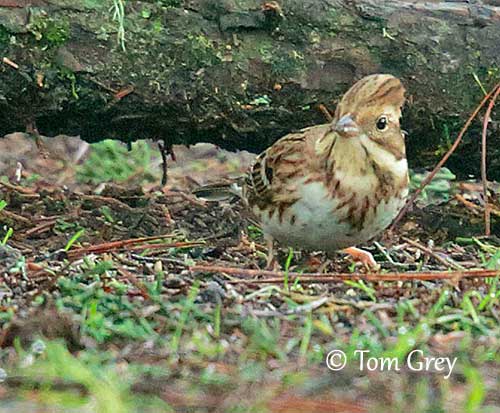
PROTECTION / THREATS / STATUS:
The Rustic Bunting is common and widespread throughout its wide range.
A very preliminary estimate of the global population size is 37,300,000/120,000,000 individuals. But further validation is needed.
Some decline in Finland, Sweden and Norway could be attributed to habitat loss, through forest management and changes in silviculture practices, involving fragmentation of forest.
But currently, the Rustic Bunting is evaluated as least Concern.